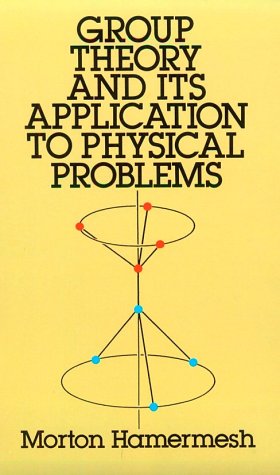
Group Theory and Its Application to Physical Problems (Dover Books on Physics and Chemistry)</SPAN>
By Morton Hamermesh
Publisher: Dover Publications
Number Of Pages: 528
Book Description:
One of the best-written, most skillful expositions of group theory and its physical applications, directed primarily to advanced undergraduate and graduate students in physics, especially quantum physics. With problems. "Well-organized, well-written and very clear throughout." — Mathematical Reviews. 71 illustrations.
http://mihd.net/smfpco
http://rapidshare.com/files/35982892/group_theory_and_its_application_to_physical_problems_ertu.rar
http://rapidshare.com/files/35982892/group_theory_and_its_application_to_physical_problems_ertu.rar
:|
Group theory and spectroscopyBy Giulio Racah
Publisher: Service d'Information scientifique
Number Of Pages:
http://rapidshare.com/files/81667679/DB-GTC.rar
:|

Problems in Group Theory
By John D. Dixon
Publisher: Dover Publications
ublication Date: 1973-06-01
Book Description:
Text deals with subgroups, permutation groups, automorphisms and finitely generated abelian groups, normal series, commutators and derived series, solvable and nilpotent groups, the group ring and monomial representations, Frattini subgroup, factorization, linear gorups, and representations and characters—in all, 431 problems. Full solutions to problems in separate section.
Link
http://mihd.net/h5zrfl
http://mihd.net/h5zrfl
:|

Chemical Applications of Group Theory, 3rd Edition
By F. Albert Cotton
Publisher: Wiley-Interscience
Publication Date: 1990-03-02
Book Description:
Retains the easy-to-read format and informal flavor of the previous editions, and includes new material on the symmetric properties of extended arrays (crystals), projection operators, LCAO molecular orbitals, and electron counting rules. Also contains many new exercises and illustrations.
Link
http://rapidshare.com/files/49303652/t00946.rar
pass: gigapedia.org
Retains the easy-to-read format and informal flavor of the previous editions, and includes new material on the symmetric properties of extended arrays (crystals), projection operators, LCAO molecular orbitals, and electron counting rules. Also contains many new exercises and illustrations.
Link
http://rapidshare.com/files/49303652/t00946.rar
pass: gigapedia.org
:|

A Course in Group Theory
By John F. Humphreys
Publisher: Oxford University Press, USA
Publication Date: 1996-06-24
Book Description:
The classification of the finite simple groups is one of the major intellectual achievements of this century, but it remains almost completely unknown outside of the mathematics community. This introduction to group theory is also an attempt to make this important work better known.
Emphasizing classification themes throughout, the book gives a clear and comprehensive introduction to groups and covers all topics likely to be encountered in an undergraduate course. Introductory chapters explain the concepts of group, subgroup and normal subgroup, and quotient group. The
homomorphism and isomorphism theorems are explained, along with an introduction to G-sets. Subsequent chapters deal with finite abelian groups, the Jordan-Holder theorem, soluble groups, p-groups, and group extensions. The numerous worked examples and exercises in this excellent and self-contained
introduction will also encourage undergraduates (and first year graduates) to further study.
Link
http://mihd.net/pqwdur
http://rapidshare.com/files/42085903/Humphreys_-_A_Course_in_Group_Theory.zip
:|

Introduction to Symmetry and Group Theory for Chemists
By Arthur M. Lesk
Publisher: Springer
Publication Date: 2004-08-03
Book Description:
This book presents to students of introductory physical chemistry the basic principles of symmetry and group theory, and their use in describing and predicting molecular structure and spectra. Symmetry is a crucial determinant of many chemical phenomena, and group theory is the grammar of the language of symmetry. In many cases, simple calculations suffice to explain why certain triatomic molecules are linear and others bent, or why certain transitions do not appear in molecular spectra.
In this book, the aim is understanding the ideas, and skills in application of the principles, rather than mathematical rigour. The book is intended as a supplement for students who want to follow up an interest in and recognition of the importance of group theory, and who seek a short and mathematically relatively undemanding introduction. Exercises appearing throughout the text are integrated with the presentation to give readers confidence in their assimilation of the material
:|
